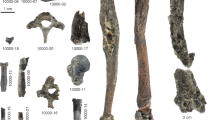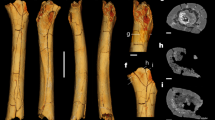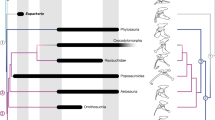Abstract
The recent attempt to show that the Hadar australopithecine female ‘Lucy’ (AL 288-1) had hindlimbs too short to allow a modern pattern of striding bipedal gait1 has important implications for understanding the origin of bipedalism, if not for the more general problem of hominid origins. Combined with previous claims that Lucy had a forelimb unusually long in proportion2 and ape-like in morphology3, the additional contention of a relatively short hindlimb would suggest a very different pattern of gait from the norm of today because the effectiveness of the pendulum action of the lower limb during stride is a function of the amount of mass in the limb4, and because a short hindlimb would necessitate a short stride length1. Yet, these contentions seem contradicted by the analyses of Lucy's pelvis (and the innomminates of other australopithecines)4,5 that indicate a similar pattern of muscle use and imply a lack of significant gait differences. Are Lucy's legs too short to allow an effective stride, or is there a different solution to this contra diction? I propose here that there is.
This is a preview of subscription content, access via your institution
Access options
Subscribe to this journal
Receive 51 print issues and online access
$199.00 per year
only $3.90 per issue
Buy this article
- Purchase on Springer Link
- Instant access to full article PDF
Prices may be subject to local taxes which are calculated during checkout
Similar content being viewed by others
References
Jungers, W. L. Nature 297, 676–678 (1982).
Johanson, D. C. & Edey, M. A. Lucy, the Beginnings of Humankind (Simon & Schuster, New York, 1981).
Senut, B. Am. J. phys. Anthrop. 56, 275–284 (1981).
Lovejoy, C. O. Yrb. phys. Anthrop. 17, 147–161 (1974).
Johanson, D. C. et al. Am. J. phys. Anthrop. 57, 403–451 (1982).
Reed, C. A. & Falk, D. Fieldania, Geol. 33, 423–44 (1977).
Mann, G. V., Roels, O. A., Price, D. L. & Merrill, J. M. J. chron. Dis. 15, 341–371 (1962).
Genovés, S. Am. J. phys. Anthrop. 26, 67–77 (1967).
Toerien, M. J. S. Afr. J. med. Sci. 19, 97–104 (1954).
Matiegka, J. Die Bambuti-Pygmäen vom Ituri (ed. Schebesta, P.) 321–353 (Mem. Inst. R. Colon. Belge, In-4, 1938).
Flower, W. H. J. R. anthrop. Inst. 18, 3–18 (1888).
Broek, A. J. P. Z. Morph. Anthrop. 38, 121–169 (1940).
Shrubsall, F. C. The Uganda Protectorate Vol. 2 (ed. Johnson, H.) 559–565 (Hutchinson, London, 1902).
Bakonyi, M. Contribution a L'Étude du Squelette des Pygmées (Ba)Mbuti de L'Ituri (Zaïre) (Université de Genève, 1976).
Schultz, A. H. Hum. Biol. 2, 303–428 (1930).
Olivier, G. Practical Anthropology (Thomas, Springfield, 1969).
Yamazuki, N., Ishida, H., Kimura, T. & Okada, M. J. hum. Evol. 8, 337–349 (1979).
Author information
Authors and Affiliations
Rights and permissions
About this article
Cite this article
Wolpoff, M. Lucy's lower limbs: long enough for Lucy to be fully bipedal?. Nature 304, 59–61 (1983). https://doi.org/10.1038/304059a0
Received:
Accepted:
Published:
Issue Date:
DOI: https://doi.org/10.1038/304059a0
This article is cited by
-
Ape and hominid limb length
Nature (1994)
-
Ape and hominid limb length
Nature (1994)
Comments
By submitting a comment you agree to abide by our Terms and Community Guidelines. If you find something abusive or that does not comply with our terms or guidelines please flag it as inappropriate.



